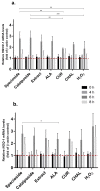Activation of the Keap1-Nrf2 pathway by specioside and the n-butanol extract from the inner bark of Tabebuia rosea (Bertol) DC
- PMID: 33214880
- PMCID: PMC7653643
- DOI: 10.12688/f1000research.26901.3
Activation of the Keap1-Nrf2 pathway by specioside and the n-butanol extract from the inner bark of Tabebuia rosea (Bertol) DC
Abstract
Background: A large number of chemical compounds exert their antioxidant effects by activation of key transcriptional regulatory mechanisms, such as the transcription factor Nrf2. The aim of this study was to evaluate the activation of the Keap1-Nrf2 pathway by both the n-butanol extract obtained from the inner bark of Tabebuia rosea (Bertol) DC and specioside isolated from this extract. Methods: The antioxidant activity of the extract and specioside isolated from the inner bark of T. rosea were evaluated using the oxygen radical absorbance capacity (ORAC) and the 2,2-diphenyl-1-picrylhydrazyl radical scavenging activity (DPPH) techniques, whereas their effects on the viability of HepG2 cells was determined using the 3-(4,5-dimethylthiazol-2-yl)-2,5-diphenyltetrazolium bromide (MTT) method. The effects of the compound and the extract on activating the Keap1-Nrf2 pathway were evaluated using a Nrf2 Transcription Factor Assay kit. Induction of the Nrf2-mediated antioxidant response genes HMOX-1 and NQO1 was evaluated by real-time PCR. The protective effects against H 2O 2-induced oxidative stress in HepG2 cells was determined as the percent protection using the MTT method. Results: Both the n-butanol extract and specioside exhibited activity at low concentrations without affecting cellular viability, since the cell viability was greater than 80% after 24 hours of exposure at each tested concentration. In addition, Nrf2 dissociated from Keap1 after treatment with the n-butanol extract at a concentration of 0.25 µg/mL after 4 hours of exposure. An increase in the Nrf2 level in the cytoplasm after 4 hours of exposure to 2 μM specioside was observed. Nrf2 levels stabilized in the nucleus 12 hours after stimulation with both specioside and the extract. After 6 hours of stimulation, both the extract and specioside induced the expression of HMOX-1 and NQO1. Conclusion: The n-butanol extract from the inner bark of T. rosea and specioside produced protective effects against H 2O 2-induced oxidative stress in HepG2 cells.
Keywords: Bignoniaceae; Nrf2; Tabebuia rosea; antioxidant agents; extracts; specioside.
Copyright: © 2020 Garzón-Castaño SC et al.
Conflict of interest statement
No competing interests were disclosed.
Figures






Similar articles
-
The n-Butanol Extract Obtained from the Inner Bark of Tabebuia rosea (Bertol.) DC, Specioside, and Catalposide Induce Leukemia Cell Apoptosis in the Presence of Apicidin.Molecules. 2024 Aug 23;29(17):3986. doi: 10.3390/molecules29173986. Molecules. 2024. PMID: 39274835 Free PMC article.
-
Nrf2-Mediated Antioxidant Activity of the inner bark extracts obtained from Tabebuia rosea (Bertol) DC and Tabebuia chrysantha (JACQ) G. Nicholson.F1000Res. 2018 Dec 16;7:1937. doi: 10.12688/f1000research.17165.2. eCollection 2018. F1000Res. 2018. PMID: 30728952 Free PMC article.
-
Willow bark extract increases antioxidant enzymes and reduces oxidative stress through activation of Nrf2 in vascular endothelial cells and Caenorhabditis elegans.Free Radic Biol Med. 2013 Dec;65:1506-1515. doi: 10.1016/j.freeradbiomed.2012.12.006. Epub 2012 Dec 28. Free Radic Biol Med. 2013. PMID: 23277146 Free PMC article.
-
Stress-sensing mechanisms and the physiological roles of the Keap1-Nrf2 system during cellular stress.J Biol Chem. 2017 Oct 13;292(41):16817-16824. doi: 10.1074/jbc.R117.800169. Epub 2017 Aug 24. J Biol Chem. 2017. PMID: 28842501 Free PMC article. Review.
-
Keap1-Nrf2 signaling pathway in angiogenesis and vascular diseases.J Tissue Eng Regen Med. 2020 Jun;14(6):869-883. doi: 10.1002/term.3053. Epub 2020 May 9. J Tissue Eng Regen Med. 2020. PMID: 32336035 Review.
Cited by
-
In Vitro Anti-Toxoplasma Activity of Extracts Obtained from Tabebuia rosea and Tabebuia chrysantha: The Role of β-Amyrin.Molecules. 2024 Feb 20;29(5):920. doi: 10.3390/molecules29050920. Molecules. 2024. PMID: 38474432 Free PMC article.
-
The n-Butanol Extract Obtained from the Inner Bark of Tabebuia rosea (Bertol.) DC, Specioside, and Catalposide Induce Leukemia Cell Apoptosis in the Presence of Apicidin.Molecules. 2024 Aug 23;29(17):3986. doi: 10.3390/molecules29173986. Molecules. 2024. PMID: 39274835 Free PMC article.
-
In Vitro Antiproliferative Activity in Plants of the Genus Tabebuia: A Systematic Review.Molecules. 2025 May 25;30(11):2315. doi: 10.3390/molecules30112315. Molecules. 2025. PMID: 40509203 Free PMC article. Review.
References
-
- Bittencourt NS, Jr, Pereira EJ, Jr, de Souza São-Thiago P, et al. : The reproductive biology of Cybistax antisyphilitica (Bignoniaceae), a characteristic tree of the South American savannah-like “Cerrado” vegetation. Flora - Morphology, Distribution, Functional Ecology of Plants. 2011;206(10):872–86. 10.1016/j.flora.2011.05.004 - DOI
-
- Blair S, Madrigal B: Plantas antimaláricas de Tumaco: Costa Pacífica colombiana. Universidad de Antioquia, Colombia.2005. Reference Source
-
- Sadananda TS, Chaithra RK, Govindappa M, et al. : Antimicrobial and antioxidant activities of endophytes from Tabebuia argentea and identification of anticancer agent (lapachol). J Med Plants Res. 2011;5(16):3643–52. Reference Source
Publication types
MeSH terms
Substances
LinkOut - more resources
Full Text Sources
Miscellaneous

